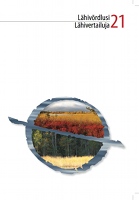Lähivőrdlusi. Lähivertailuja
Close Comparisons
Publishing House: Eesti Rakenduslingvistika Ühing (ERÜ)
Subject(s): Language and Literature Studies
Frequency: 1 issues
Print ISSN: 1736-9290
Status: Active
- 2010
- 2011
- 2012
- 2013
- 2014
- 2015
- 2016
- 2017
- 2018
- 2019
- 2020
- 2021
- 2022
- 2023
- 2024
- Issue No. 19
- Issue No. 20
- Issue No. 21
- Issue No. 22
- Issue No. 23
- Issue No. 24
- Issue No. 25
- Issue No. 26
- Issue No. 27
- Issue No. 28
- Issue No. 29
- Issue No. 30
- Issue No. 31
- Issue No. 32
- Issue No. 33
- Issue No. 34
Articles list
{{ article.TitleOriginalLanguage }}
{{ article.TitleOriginalLanguage }}
({{ article.TitleEnglish }})
- Publication: {{ article.Publisher }} ({{ article.Issue }})
- Author(s): {{ article.Authors }}
- Contributor(s): {{ article.Contributors }}
- Language: {{ article.Language }}
- Subject(s): {{ article.Subjects }}
- Issue: {{ article.Issue }}
- Page Range: {{ article.PageRange }}
- No. of Pages: {{ article.NumberOfPages }}
- Keywords: {{ article.Keywords }}
- Summary/Abstract: {{ article.SummaryAbstract }}
- Price: {{ common.currency(article.Price) }}
Short Description
Lähivertailuja has traditionally been a series of Finnish-Estonian comparative research, which has a remarkable role in Estonian and Finnish linguistics. The first volume of the series was released in 1985 and in total there have been 18 editions. Estonian Association of Applied Linguistics has accepted the proposal to start publishing Lähivertailuja as an EAAL series from its 19th volume on (published in May 2010) and that without changing the existing numeration. The main goal is to ensure ongoing viability, international editorial conventions and the timeliness of publication. EAAL publishes one volume per year in October, starting with the volume 20. The title of the edition is in both Estonian and Finnish: Lähivõrdlusi. Lähivertailuja. Lähivõrdlusi. Lähivertailuja as an EAAL edition is a series of articles of comparative and second language acquisition research, all of which must be peer reviewed by two anonymous referees. Studies of the following topics are published in the series: * comparative research of Estonian and Finnish; * other types of comparative research, which include Estonian or Finnish; * mutual learning of Estonian and Finnish; * other second or foreign language learning research, in which the target language is Estonian, Finnish or another Finno-Ugric language. Articles can be written in Estonian, Finnish or English. The summary for an article written in Estonian or Finnish should be in English, for an English article again in either Estonian or Finnish.

